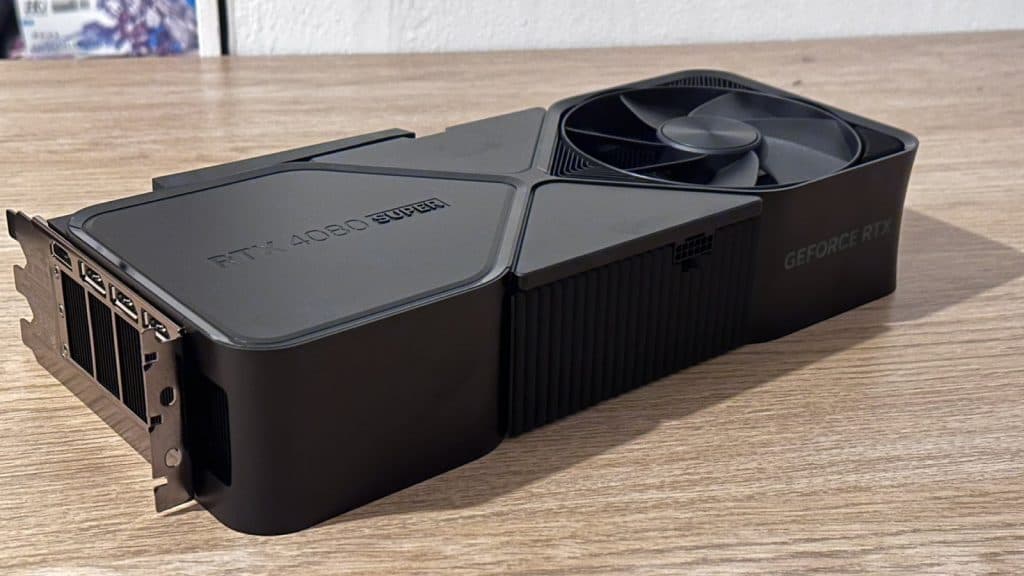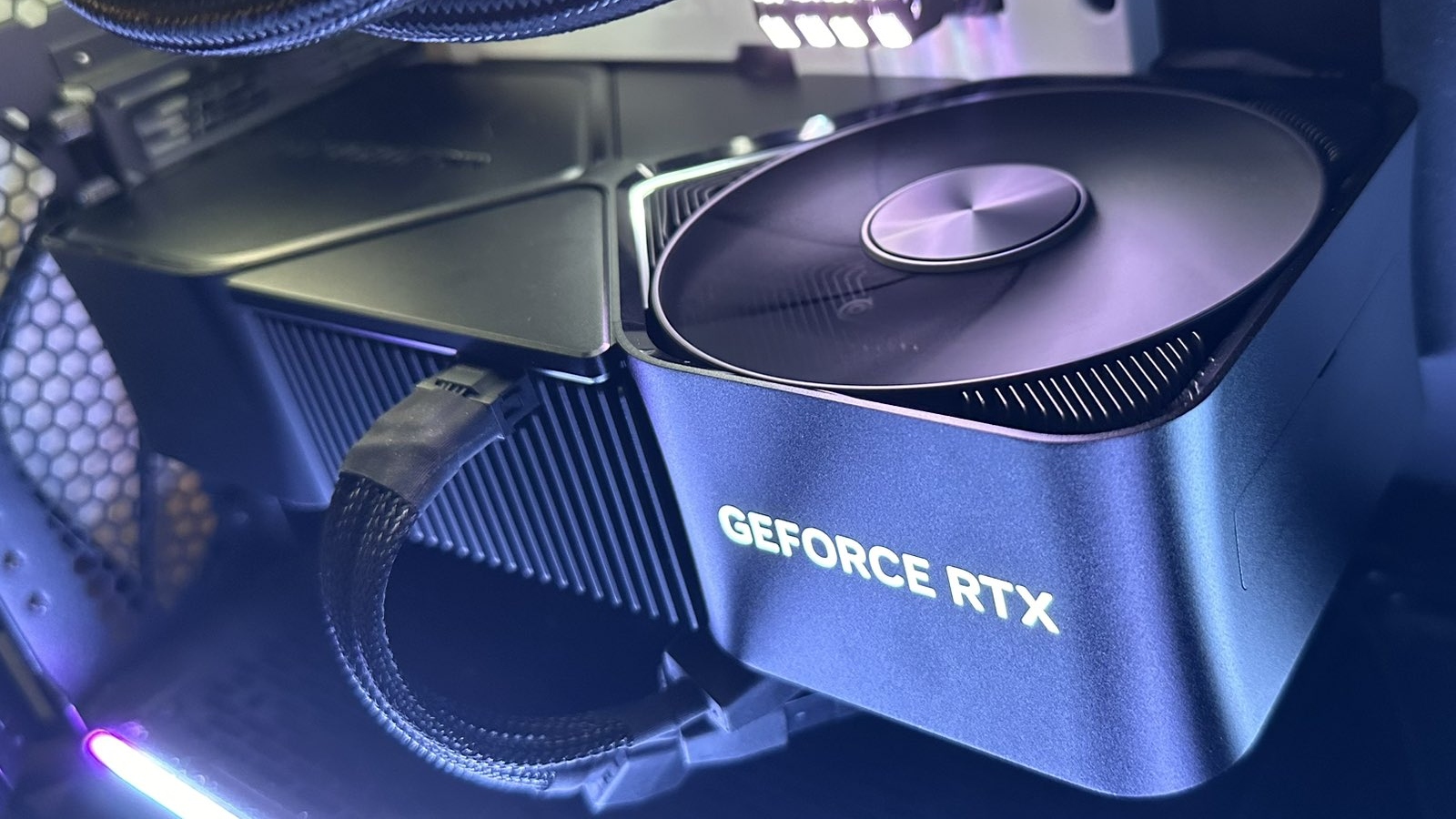Nvidia’s RTX 4080 Super is here, and we’ve put it through our benchmarks to tell you whether or not you should pick up the new GPU.
Nvidia’s RTX 40 Super lineup has been a bit of a mixed bag, while the 4070 Super is incredibly impressive, and offers heaps of value at the same MSRP as the vanilla model. Meanwhile, the RTX 4070 Ti Super offered a modest performance uplift at the same price as the original. But, the RTX 4080 Super aims to deliver slightly more performance, at $200 cheaper than the original 4080.
The RTX 40-series is an expensive lineup of graphics cards. The price-to-performance ratios of the 30-series were not replicated, leading to some users sticking with their older-gen cards, instead of upgrading. But, does this refresh offer value to those who have been languishing with 20-series GPUs?
We’ve put the 4080 Super to the test to see for ourselves if the saving is worth it, or if you should still just save up some pennies for an RTX 4090.
Key specs
Design

The RTX 4080 Super Founders Edition is a looker. The sleek, metallic triple-slot cooling solution looks great with a blacked-out look. The flow-through design is ideal for tower cases, but those wanting to put it into an ITX system might want figure out their case’s airflow first. It’s by far one of the best quality GPU coolers out there, and it also manages to not look like some kind of weird alien spaceship, like so many other AIB partners choose to do.
The Geforce RTX logo and a chevron can be lit up, but that’s about it, with a 12VHWPR connector upon its side. There’s a bundled adaptor if you’re not yet on the ATX 3.0 train, to boot. Like the RTX 4080, I wish the power connector placement was different, and allowed for neater cable management at the front of your case here, but that matters very little once the GPU is up and in action.
Chips & choices
The RTX 4080 Super makes use of the AD103 chip we’ve seen in the RTX 4080 and 4070 Ti Super. But, this time we not only get more power, but more cores, and a higher clock speed. It would have been good to see Nvidia choose a cut-down of the RTX 4090’s AD102, but I assume that this would have made the GPU prohibitively expensive for the price point they wanted to hit.
You still get 16GB of GDDR6X VRAM here, which is likely more than enough for most 4K gaming workloads. All this is powered by 320W of power, and if other RTX 40-series chips are anything to go by, it could be quite efficient while gaming.
That cut-down price
When comparing the RTX 4080 Super and the standard 4080 release from 2022, it’s easy to question whether this really is worthy of the “Super” name at all. Cores have received a slight boost, and Nvidia even claims that the performance of the older card might be undetectable while accounting for variance between chips and performance runs. In reality, the company is targeting a meager 4-5% performance uplift. This is all to serve the $999 price point that the GPU is set to launch at.
This would mean that you’ll be getting all the power of a 4080, and potentially more, at under that golden $1000 price point. But, does the GPU really manage to deliver on that promise? We find out.
Performance
The RTX 4080 Super is a bona-fide 4K GPU, with stellar 1440p performance. While the GPU will suffice at those resolutions, I still anticipate a gap between the GPU and the king of graphics cards: The RTX 4090. We’ve benchmarked the GPU at 4K and 1440p to give you all the data you need to compare performance between the GPU and its biggest rivals.
We’ve made use of DLSS 3, and ray tracing in our benchmarks. We have not yet chosen to use a path-traced benchmark in our results due to simply too few games actually shipping with the feature.
Test System
- CPU: AMD Ryzen 7 5800X3D
- CPU Cooler: Cooler Master PL360 Flux
- Motherboard: NZXT B550
- RAM: 32GB Corsair Vengeance DDR4 @ 3600 MHz
- Case: Lian Li Lancool II Mesh
- PSU: Cooler Master MWE Gold V2 850W
RTX 4080 Super 4K gaming performance
The RTX 4080 is the ruler of the roost, when it comes to performance at 4K in the sub $1000 segment. It is faster than the standard RTX 4080 by around 2.5% on average in our benchmarks, which aligns with what we expected from the GPU. While it doesn’t offer performance that’s leagues ahead of the standard RTX 4080, it’s still a slight bump in performance.
Compared to the RTX 4070 Ti Super, it’s a much more attractive proposition at a 32% increase in performance while being 22% more expensive, meaning that your dollars are going to go further at 4K by spending a bit extra.
Fewer Ads|Dark Mode|Deals in Gaming, TV and Movies, and Tech
RTX 4080 Super 1440p gaming performance
At 1440p, the RTX 4080 Super is a surefire triple-framerate dominator, managing to break through in all benchmarks aside from native ray traced workloads. Here, we observed a 4% difference in performance between the RTX 4080 Super and the vanilla variant, which is well within the expected performance uplifts.
Again, the real story is the value offered here, with the RTX 4070 Ti Super sitting at 24% slower than the 4080 Super here, which roughly equates to the same performance-per-dollar for both cards at this resolution. While the 4080 Super in itself is a fast GPU, it’s here that I feel as though a bit more power under the hood could have gone a long way to make the proposition more attractive to users.
Synthetic benchmarks
Synthetic benchmarks are also a good way at looking at simulated GPU scenarios, and the RTX 4080 Super performed admirably. There’s a 3% performance difference compared to the vanilla RTX 4080, which is in line with gaming benchmarks. Compared to the RTX 4070 Ti Super, you can expect an 18% difference in performance here, too.
The RTX 4090 still roars ahead in synthetics, being around 24% faster than the RTX 4080 Super. It seems like nothing can stop Nvidia’s flagship GPU, despite being several years old.
Thermals, power & noise
The RTX 4080 Super drinks around 320W of rated power. Under a stress test, we saw this figure peak at around 311W in total, which is well within specifications. The GPU’s power usage in gaming benchmarks peaked at around 300W in Cyberpunk 2077, which is an extra boon for those looking to save pennies on the electricity bill.
Even when boosting up to 311W under load, we saw the RTX 4080 Super reach no higher than 77 degrees under a sustained load, which is impressive. Nvidia’s flow-through cooler design is still one of the best out there, and will allow you to sustain maximum clock speeds in most workloads. Noise is also never an issue here, with the GPU’s default fan curves allowing for a classic fan-stop mode, as well as never getting too noisy, aside from errant coil whine when running certain high-frame-rate titles.
Should you buy it?
The RTX 4080 Super is a good graphics card, it’s superbly fast, edges out its predecessor, and comes with a cheaper price tag. So, what’s not to love? Well, the performance difference between the RTX 4080 Super and RTX 4090 still leaves a little to be desired, there’s still ample space for Nvidia to come in and release an RTX 4080 Ti to bridge the gap here. But, at under $1000, it’s the best graphics card you can buy today. But, those willing to spend extra on the RTX 4090 will still receive much more performance.
Verdict: 4/5
The RTX 4080 Super is a great graphics card that can scream through most workloads at 4K, 1440p, and, of course, 1080p, even though it’s a bit overkill for that particular use case. It brings a healthy $200 discount to the RTX 4080’s power, meaning that purchasing this GPU actually makes sense. It also banishes AMD’s RX 7900 XTX into near irrelevance with its frame-generation, DLSS features and ray tracing heft. Given the gap at the top between the 4080 Super and RTX 4090, don’t be shocked if Nvidia chooses to plug that gap before we see the 50-series release.
If you click on a product link on this page we may earn a small affiliate commission.


